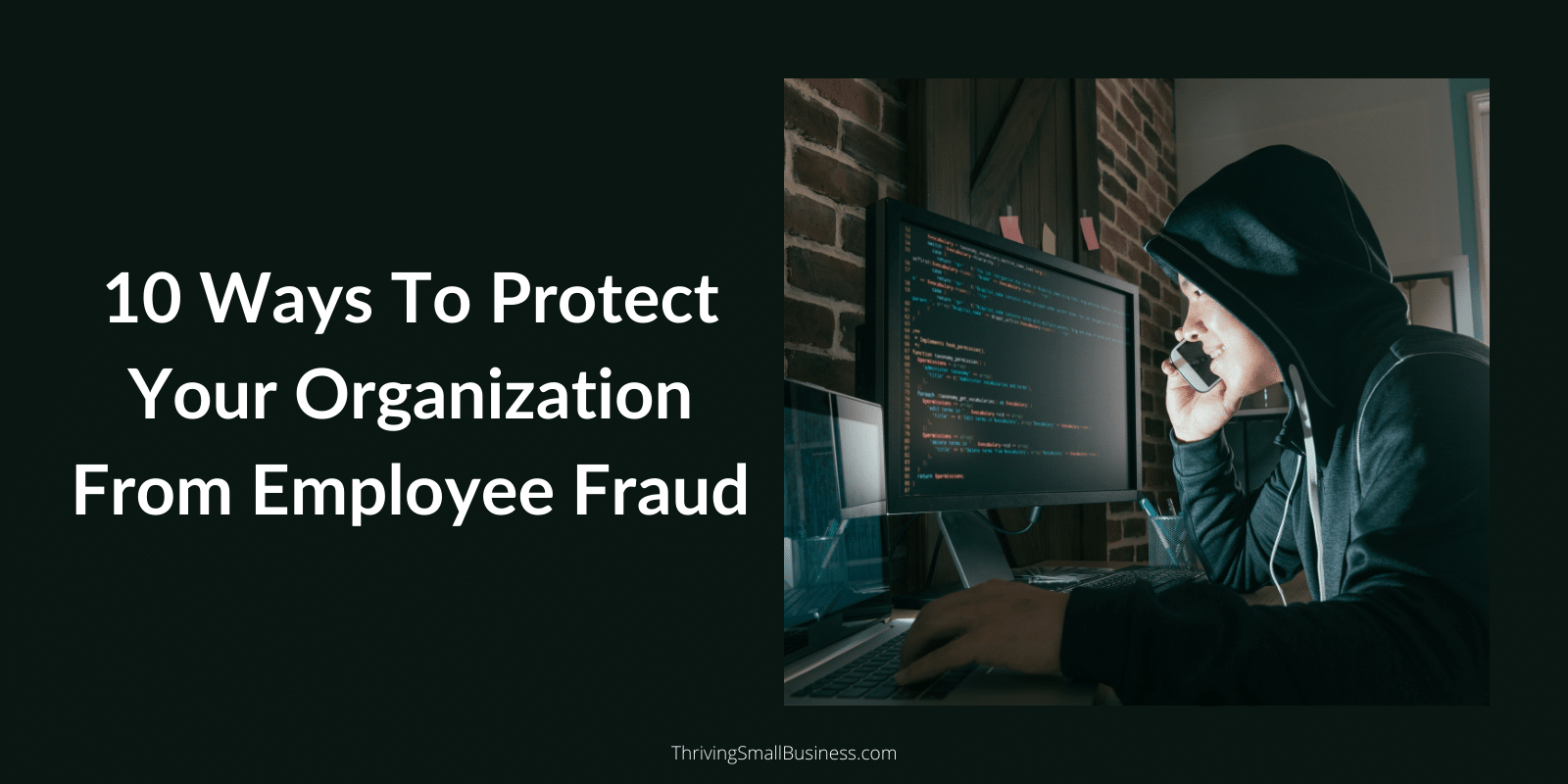10 Ways to Protect Your Organization from Employee Fraud
Estimated reading time: 5 minutes
No business owner ever expects his/her organization to have to deal with employee fraud. However, fraud and embezzlement are very real issues for businesses.
Employee fraud costs businesses billions of dollars every year.
According to a 2008 report by the Association of Certified Fraud Examiners (ACFE), 994 billion dollars are lost every year to employee fraud.
This equates to businesses losing a staggering 2.7 billion dollars every day!
ACFE defines occupational fraud as: “the use of one’s occupation for personal enrichment through the deliberate misuse or misapplication of the organization’s resources or assets.”
“Fraud is now so common that its occurrence is no longer remarkable, only its scale.
Any organization that fails to protect itself appropriately faces increased vulnerability to fraud.”
Fraud is typically triggered by what is called the fraud triangle.
What Is A Fraud Triangle?
The fraud triangle is financial pressure, a rationalization for the act, and the opportunity to commit fraud.
The current economic environment creates desperate situations for people and it is the organization’s responsibility to have systems in place to protect both the organization – as well as the employee.
A good employee put in an uncontrolled environment might do things they would not ordinarily do because of external pressures.
ACFE founder and Chairman Dr. Joseph T. Wells, CFE, CPA, writes in “Small Business, Big Losses” that “small businesses remain the most vulnerable to occupational fraud because of three factors: They are the least likely to have an audit, a hotline or adequate internal controls.”
Little Known Stats About Fraud
- Most fraud cases are in manufacturing, banking, and insurance;
- The median loss is $175,000;
- A large number of fraud cases are never reported;
- It is the first offense for most offenders;
- Fraud is most often committed by upper management and accounting employees;
- Only 7% of those caught have a history of theft;
- Most fraud starts small, develops, and grows over time;
- Since most are first-time offenders, background checks don’t reveal them;
- Almost half of the incidents involve more than one person;
- Fraud is most common in organizations with less than 100 employees;
- It usually takes about 18 months to catch someone stealing;
What Are The Signs Of Employee Fraud?
- Behavioral changes;
- The obvious use of drugs or alcohol;
- Someone living beyond their financial means;
- An employee who doesn’t take time off;
- Financial pressures at home;
10 Ways to Protect Your Organization from Employee Fraud
1. Create a Written Fraud Policy
Create a written fraud policy and include things like:
- Definition of what fraud is – you may be surprised that many employees don’t understand the term.
- Zero tolerance for fraudulent behavior – emphasize that one incident will be enough to warrant termination.
- How an investigation would be done – describe in detail what the process would be like and how it would impact an employee’s privacy, reputation, and employment.
- Consequences – immediate termination – employees need to understand that there is no begging for forgiveness.
- The outcome of fraud – prosecution – helps employees understand the sober impact of their behaviors.
2. Policy Training
The best way to help employees and managers understand a fraud policy is to conduct formal training on the policy.
Update the policy annually and incorporate policy training into the new employee orientation process.
Helping employees understand the organization’s commitment to protecting its assets is a great deterrent to possible fraudulent behavior.
3. Have Good Internal Controls
Why Are Good Internal Controls Important To Reducing Fraud?
- Internal controls help keep the organization accountable for accurate financial information by protecting assets;
- Allow for accurate information to plan and monitor business operations;
- Maintain compliance with federal, state, and local laws;
- Provide a mechanism to monitor organizational goals.
4. Have Investigation Procedures
There should be a clearly defined process to investigate questionable behaviors and/or financial information.
Defining the process ahead of time allows for a more timely and efficient investigation.
5. Two-Person Rule
It is never good practice to designate a single person to pay bills and monitor bank statements.
Assign at least two people responsible for paying bills and looking at bank statements.
Require monthly reporting, and read the reports!
6. Have a Confidential Tip Hotline
Make it easy for employees to report something that is questionable.
For instance, some organizations use confidential tip hotlines. This is a message center that employees can call and give a confidential statement.
The more simple (and confidential) the process, the more likely it will be for employees to make the organization aware of suspected fraudulent activities.
7. Enforce Mandatory Vacations
Taking time away from the office is not only good for employee morale but is also good for the organization.
Make sure that every position, with even remote access to cash or assets, has a trained backup.

Add to your employee policies a requirement to take the minimal allowed PTO time away from work.
Pay attention if someone is resisting this request or hesitates to train a backup for their job.
8. Use a Safe for Cash
Incorporate the use of a safe for all cash as part of your internal controls.
Require those who handle cash to use the two-person rule for handling cash transactions and have a safe with a dropbox to allow for a limited number of people to have access to the safe combination.
9. Review Internal Control Processes
Once an internal control process is created, make sure you review and audit it at least annually.
Talk to employees who use it and spend some time refining and improving the process for the organization.
This conversation can serve as another deterrent because it gives employees notice that you are paying attention.
10. How To Conduct an Internal Audit
Conduct an internal audit and ask the following questions:
- Who has access to the accounting system?
- How are they supervised?
- Is there more than one person involved in all accounting processes?
- Are all supplies accounted for?
- Is there a process to recognize supply shrinkage?
- Does the company owner review monthly bank statements?
Who Is Responsible For Protecting
An Organization From Employee Fraud?
It is the responsibility of the board and senior management to ensure the organization is protected against fraud.
Having good internal controls and consistent auditing processes can help to eliminate the opportunity for fraud within your organization.
What do you do to protect your organization against fraud?
Check out The Corporate Fraud Handbook to help with the next steps!






